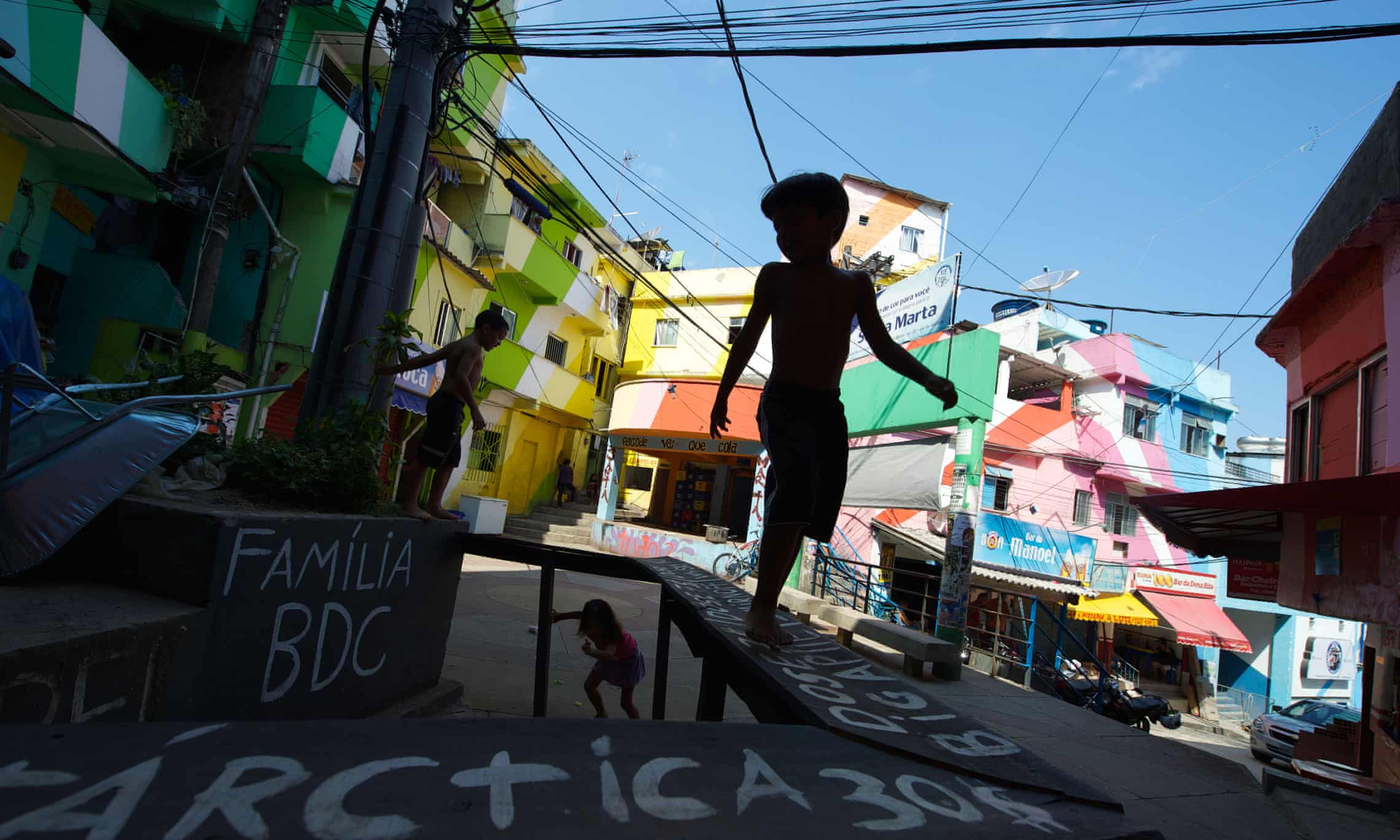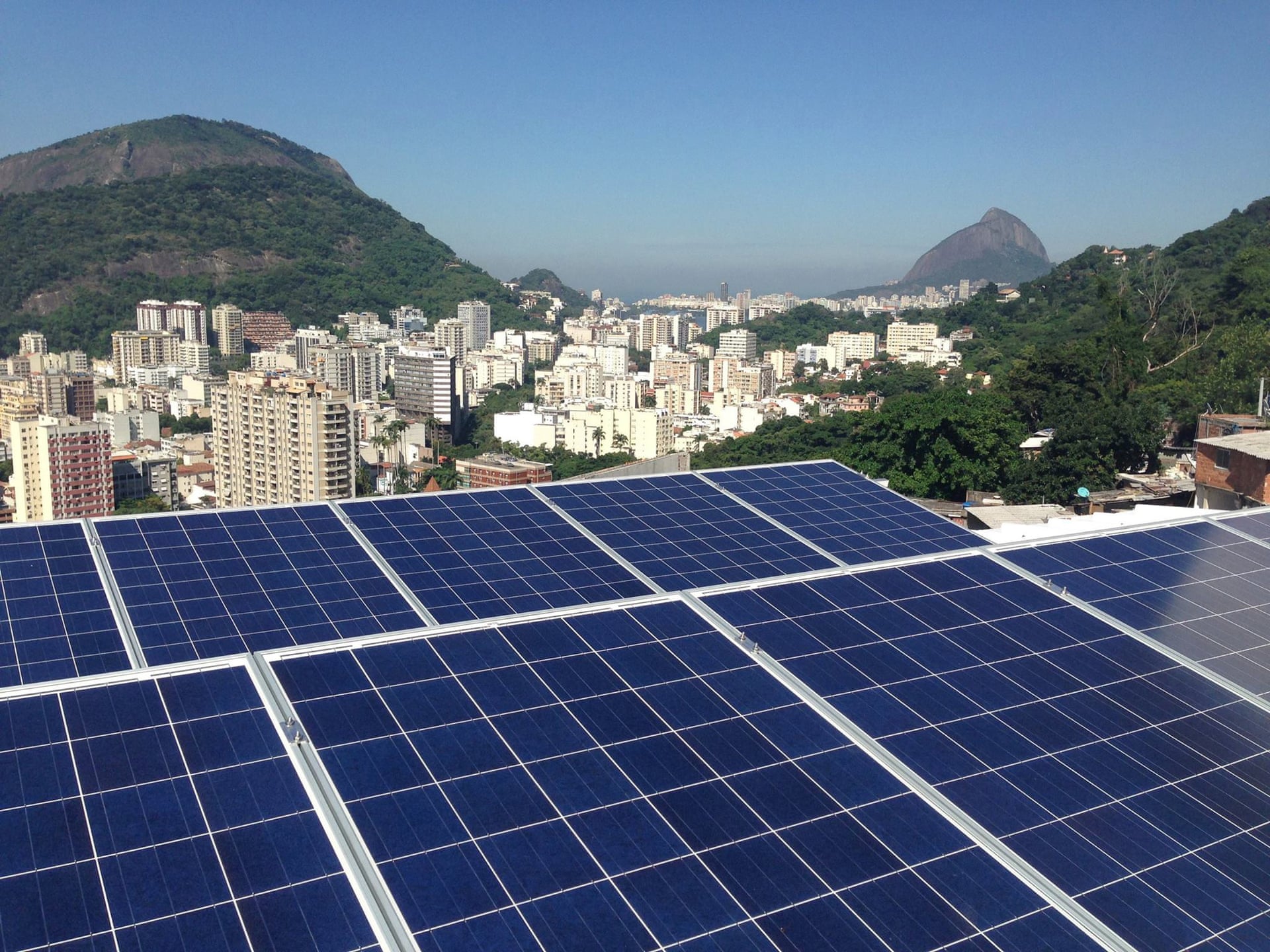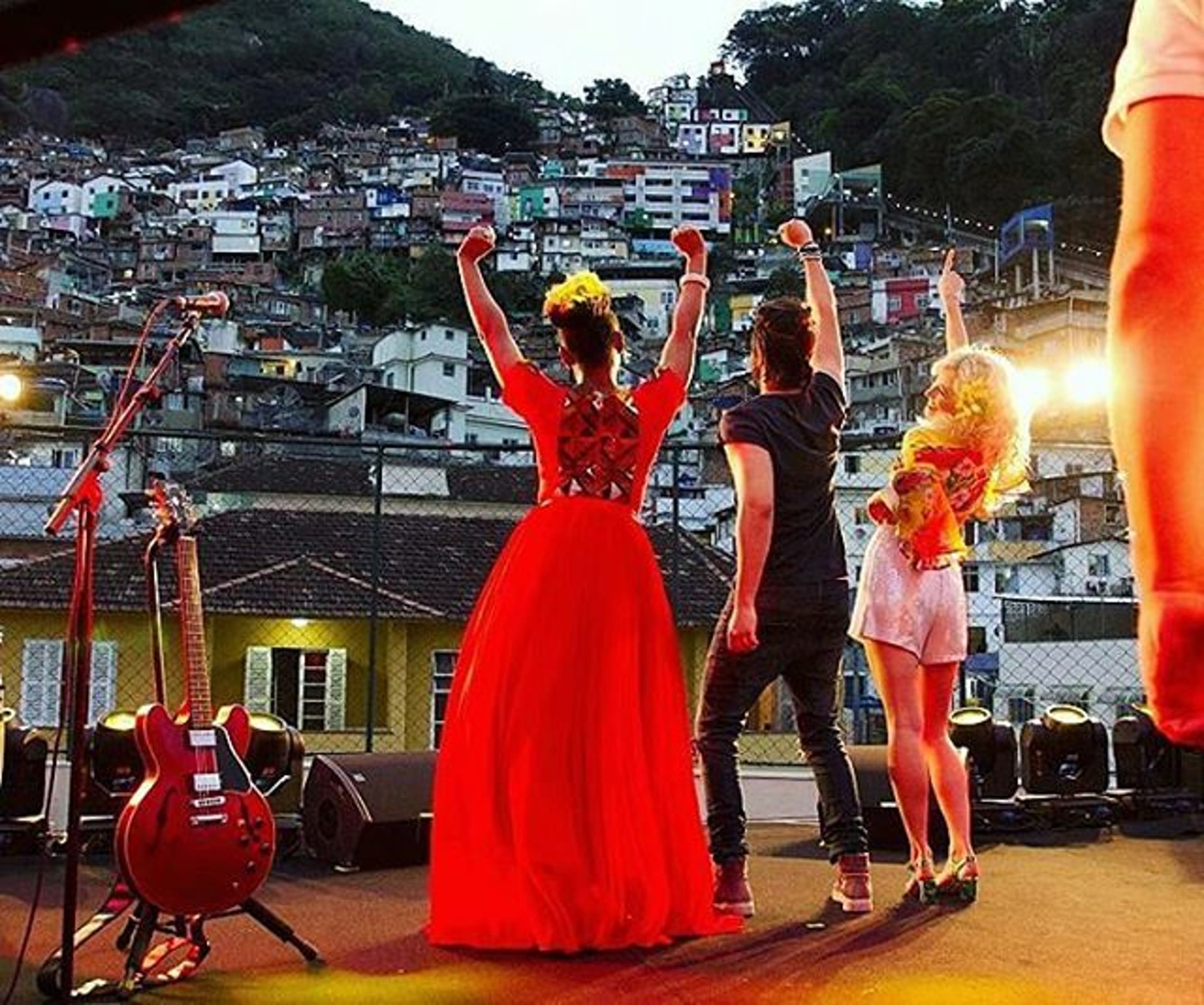
Children play in Rio de Janeiro’s Santa Marta favela. Photograph: Alamy Stock Photo
Shell is not an obvious champion of sustainable business ideas but, beyond the glitz of an event staged in a Rio favela, and featuring pop stars like Pixie Lott, the oil firm has a chance to show it is serious about renewable energy investment...
Can you imagine a more affordable source of lighting for the world’s poorest families than a lamp powered by gravity, or a more ingenious way to charge electric cars than by harvesting the air turbulence they cause alongside motorways? Can you imagine more fitting forms of clean energy for Brazil than barbecue fuel briquettes made from used coffee beans, or football floodlights powered by the players’ runs on the pitch?
These are among the sustainable business ideas being showcased in Rio de Janeiro this week at an event that mixes seven startups, three saccharine sweet pop stars and and one fossil-fuel behemoth – Shell – in a campaign to #changetheworld and clean up the latter’s dirty corporate image.
Staged in the striking setting of the Santa Marta favela, the event blends recycled macchiato and the British singer Pixie Lott, kinetic-energy producing football pitches and Brazil’s Luan Santana, weight-powered lights and Nigeria’s Yemi Alade in a 21st-century public relations concoction par excellence.
But for all the fluff, corporate cynicism and the army of media communication consultants, there was just about enough intelligence and idealism on display to ensure the event inspired a little hope as well as suspicion.
The overarching concept was simple: take seven sustainable business ideas that normally receive little attention, then ramp up their prominence and impact with a promotion event in a sexy location with big-name artists who can amplify the message to a young audience through music videos, Snapchat and other social networks.
Luan Santana, Yemi Alade and Pixie Lott performed at Shell’s #makethefuture launch event in favela Santa Marta. Photograph: #makethefuture/Shell's Facebook page
It was a little weird, nonetheless, to see the world’s third most valuable oil company temporarily commandeer a favela to produce a music video about clean energy and stage a press conference with canapguardian canapés for journalists flown in from distant continents. The dissonance was both encouraging and unsettling.
Encouraging because the overriding message was that positive change is possible. Santa Marta is a symbol of that. Fifteen years ago, this community of 8,000 residents – like many favelas in Rio – was off the social grid. Gangs ruled the streets. There was almost zero public or private investment. Residents stole electricity by tapping power lines so there was little incentive to conserve energy or switch to clean power.
But since 2008, when it was the first favela to be “pacified” with a permanent police presence, Dona Marta has become something of a model community. A new cable car has improved access. With crime down, tourism – driven by the spectacular views of Rio and the nearby Christ the Redeemer statue – is up. The utilities have moved in. Some new homes have installed sewer pipes and electricity cables.
Since the end of last year, this is also the site of a pilot project to bring solar power to favela communities. Shell is paying the small local startup Insolar to install more than 150 photovoltaic cells on buildings with a communal use. Look down now from the cable car and you can see blue panels on the creche, samba school and residents’ association. In the near future, there will be solar trees, where locals can charge mobile phones.
“People thought we were crazy when we said we want to promote solar use in poor communities in Rio,” said Insolar founder Henrique Drumond. But he said the creche now gets 70% of its energy from the panels, which means considerable savings on a power bill that – since pacification – has to be paid. With a panel lifespan of 25 years and lots of sun in Rio, the hope is that, over time, residents of other communities will see the benefits and – once a financing system is in place – choose to invest themselves. In that sense, Santa Marta is a shop window.

Solar panels on the roof of the creche in Santa Marta, installed by local startup Insolar and paid for by Shell. Photograph: Courtesy Insolar
“Solar brings energy and jobs,” said the community “ambassador” Marcelo de Souza. “We hope this can spread not just in Santa Marta but to all the Rio communities. We want to create not just jobs, but business.”
Commercial viability is, however, still a distant prospect for most of the projects being exhibited. A greater priority for now is demonstrating that the technology works and getting the word out. This is where Shell’s marketing clout – rather than an equity investment – comes in.
That process is already well underway at Pavegen, a UK company that built the world’s first player-powered football pitch at Rio’s Morro da Mineira favela in 2014. That too was a Shell-sponsored project and – with their backing – inaugurated by Pelé.
The idea is ingenious, but expensive. Kinetic energy panels are laid under the playing surface. Each step on them generates about five watts (depending on the player’s weight). A single five-a-side game can power floodlights for several hours.
Underscoring the importance of public security as well as energy in any development, the founder, Laurence Kemball-Cook, was advised not to return to Morro da Mineira because of rising violence in the unpacified community, but his company’s technology was showcased at Santa Marta with a breakdance display.
Kemball-Cook initially had to take risks to push his ideas. He says his first pilot project was installed without permission on a building site on the South Bank and he was also detained for putting one on the steps of 10 Downing Street. Now, however, he has Shell’s support, £2m raised from a kickstarter campaign, 40 staff and a growing list of trial sites, including West Ham station, a Kia factory in South Korea and – soon – several entire blocks of a US city. He is hopeful the collaboration with music artists can take it further, increase demand and help to drive the cost down.
“If you believe in an idea, you can’t just sit on your backside,” he said. “We have great technology, but amplifying it is hard. We partner with artists to amplify it. A 16-year-old won’t listen to me or to Shell but, with a song, you can reach them.”
The artists – who will collaborate for a promotional video – were chosen to appeal to global youth with one representative from each continent. Of the three who were in Santa Marta this week, Santana has 50 million social media followers, Alade is a Nigerian afropop star, and Lott was recently in a West End show.
“The idea is to spread the word about these fantastic ideas,” said Lott, who performed on the roof of a favela creche, while on the street below visitors were shown around display booths. “It is really good to be involved in something so positive and inspiring. These are fantastic ideas that I would have never thought about from people who really care about the world. I hope these things become normal in the future. It is really important for young people to realise it’s going on.”

Yemi Alade, Luan Santana and Pixie Lott perform in the Santa Marta favela. Photograph: @yemialadeworld
Youth appeal, however, is probably more important for Shell – which needs to greenwash its 100-plus-year history of profiting from dirty carbon fuels – than for the young entrepreneurs, most of whom are more in need of backing from investors and governments.
Take Sanwal Muneer, founder of Capture Mobility, a firm that produces roadside turbines that generate energy from the air turbulence caused by passing cars. These sophisticated devices also tap solar power and use filters to remove harmful pollutants from vehicle emissions. Having started in Pakistan last year, it is now based in Edinburgh and is already planning four major pilot projects, including one in Germany that will use the collected power to charge electric cars.
Arguably the most elegant idea on display was also the simplest. Gravity Light, a UK-based firm, aims to provide power – with a ceiling winch and a bag of sand or stones – to the one in seven homes in the world that lack electricity. All users need to do is pull the weight up and let it fall. This turns a small turbine that can power an LED light (or a radio) for up to 25 minutes. In its target market of sub-Saharan Africa, the price would be just $25 (£19) for an energy source that would last for several years, does not require batteries and would be several times brighter – and, ultimately, much less of a drain on household finances – than kerosene lamps, which are currently the main alternative source of lighting.
Other entrepreneurs get power from waste. China-based MotionEco turns used cooking oil into diesel, thereby reducing the public health threat of a product that has, notoriously, been scooped out of gutters and reused for food. UK-based Bio-Bean collects industrial quantities of used coffee and extracts essential oils and biodiesel and then uses what is left to make fuel briquettes that, it says, are cheaper and longer-burning than wood.
On the main road of Santa Marta, the latter were being used to grill chicken kebabs and sausages at one of the ubiquitous street churrascos. Daniel Crockett, the communications head of the three-year-old company, hoped the principle could spread further.
“Coffee is just one organic waste stream. If we could spread the idea that this is possible then that would be great,” he said. “But we know that many of these places have more pressing issues of clean water and basic sanitation.”
That touched on one of the three unsettling questions raised by the event. Will Santa Marta turn out to be a Potemkin favela used to temporarily showcase the future even as other communities are unable to enjoy the basic services that should be available in the present?
The second question is about Shell’s motives. Is it genuinely pushing for an energy transformation, simply hedging its bets, or just engaged in PR to salvage its reputation, particularly among the young ? It is probably no coincidence that #changetheworld comes at a time when there is growing pressure from students for universities and other institutions to divest their funds from fossil fuel companies.
Shell declined to say how much it spent on the project in Santa Marta, though it – and other clean energy investment by the company – was almost certainly minuscule compared with its investments in dirty carbon-based energy. The third question, then, is will that balance shift?
The company’s external relations manager, Glauco Paiva, was clear in his answer. “Shell believes the future of energy is renewable,” he said at a press conference in the Santa Marta samba school hall. “The idea is to change the world.”
If so, this week’s exhibition is a tiny but welcome step in the right direction. But if Shell’s investment strategy does not also change substantively, the bright ideas will have been shrouded in a PR sham.
Global development is supported by 
Monday 3 October 2016 02.00 EDT
source: https://www.theguardian.com/us
original story HERE
Get more of The Global Warming Blog. Bookmark this page and sign up for the blog’s free RSS Feed. Sign up for free Global Warming Blog by clicking here. You will automatically be emailed a regular summary of the latest global warming headlines.
To help do something about the climate change and global warming emergency, click here.
Sign up for our free Global Warming Blog by clicking here. (In your email, you will receive critical news, research, and the warning signs for the next global warming disaster.)
To share this blog post: Go to the Share button to the left below.


Be the first to comment
Sign in with